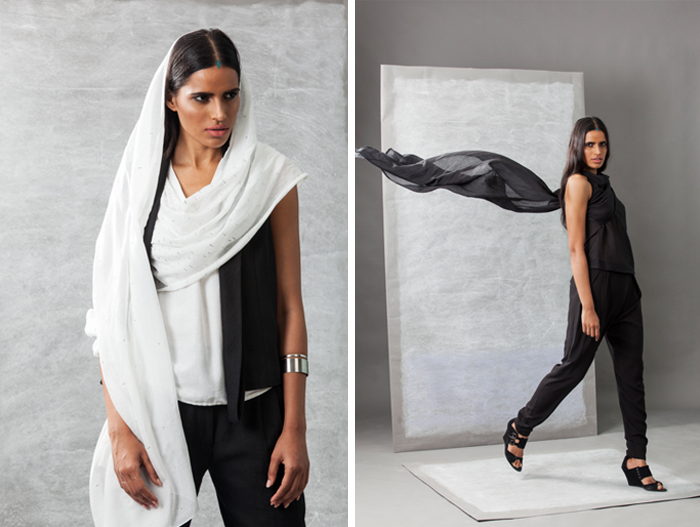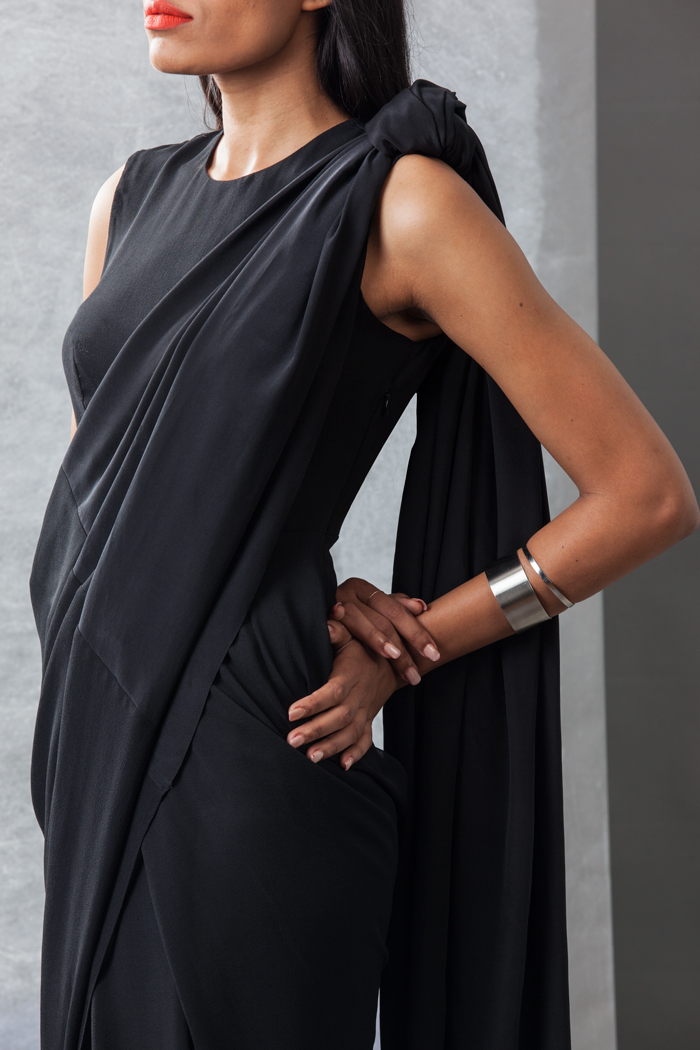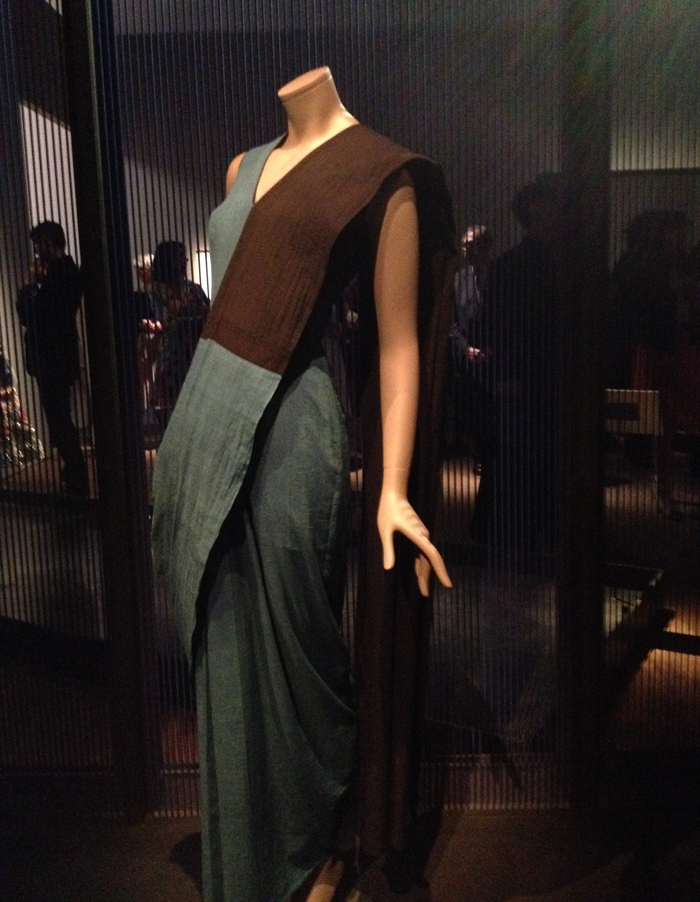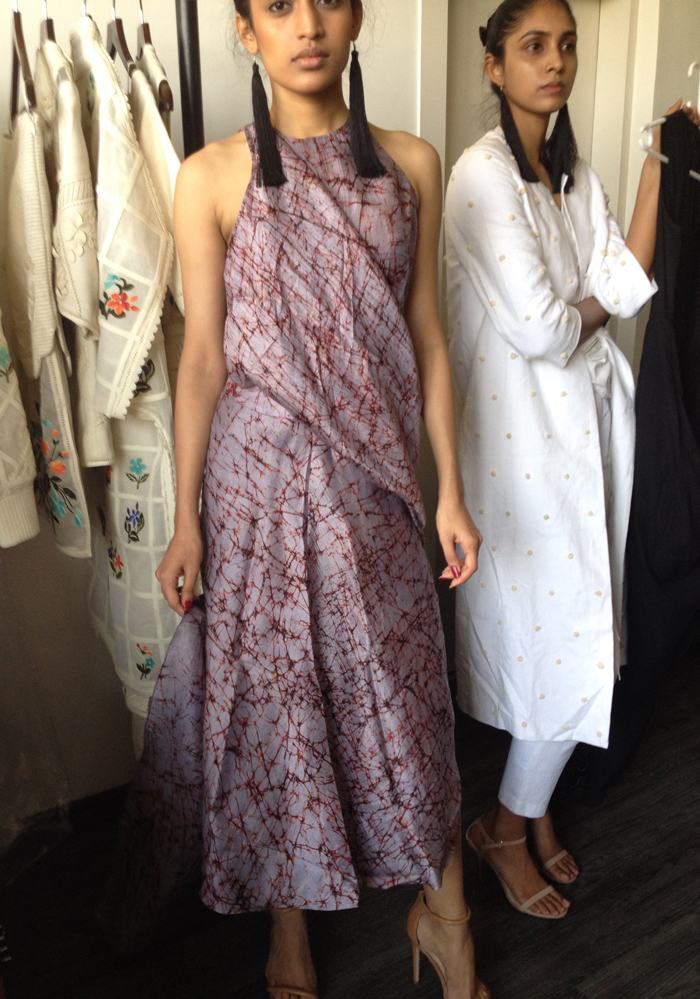Informed by her multidisciplinary design pursuits spanning fashion, costume, interior design and architecture, Rashmi Varma equally draws from her years spent in Montreal (her birthplace), Toronto, Jubail and New Delhi – having settled in the latter in early 2013 to begin her womenswear brand, Rashmi Varma. Layered and visually driven, she has been known to watch films twice, the second time without sound. Above all, she is interested in developing aesthetics and has recently documented India’s everyday design objects as a co-author of Sar: The Essence of Indian Design.
The beginning > My obsession with clothing began very young. I recall an early sartorial moment when my family and I were to fly somewhere from my hometown, Montreal, I must have been five. I owned a pleated skirt and navy blue blazer (with white piping and a flower on the lapel), which I insisted on wearing as my travel suit. It felt so sharp and official and, perhaps, I liked the uniformity of the flight attendants. My little suit brought me a lot of attention and I have to admit that I thoroughly enjoyed it but more importantly, in that moment, I understood the power of dress.
 Above: image | Spring Summer 2015 Bihar khadi indigo sari dress, Kacchh draped top/kacchh pant.
Above: image | Spring Summer 2015 Bihar khadi indigo sari dress, Kacchh draped top/kacchh pant.
I decided in my early teens that I wanted to study fashion design. My parents at the time, however, told me to get a “real degree” as art or design was just not understood as a professional career. I completed my bachelor’s in Political Science in 1996 and later switched to interior design. It was still design heavy and felt like a more viable career option than fashion in terms of finding work. I had convinced myself that fashion was not the best career move but continued to express my love for clothes through personal style.
I landed my first job with a small architectural firm in Toronto and about a year and a half later, another with a corporate interior design firm. I learnt a tremendous amount from both – professionalism, working with clients, technical design skills and the difference between good, bad and no design.
Above: image | Fall Winter 2015-16 silk chintz bomber detail
There was a whole lot of experience but the type of projects didn’t fuel my design dreams. Working on generic cookie-cutter design projects such as Burger King, Payless ShoeSource stores and Shoppers Drug Marts was not the kind of work I dreamed about. So I left that world and eventually returned to clothes. With clothing, I was able to control the process of creating and see faster results compared to architectural or interior design projects.
Interdisciplinary design practice > After returning from a trip to India in 2002, I started experimenting with cutting, ripping, sewing and embellishing fabric while managing a designer’s boutique in Toronto. Not wanting to study full time, I took two night courses in sewing and pattern making and basically taught myself the rest by working with Canadian designers like Denis Gagnon, YSO and Meghan Kinney. I watched carefully how they worked and picked up elements from garment construction and fittings to understanding the commercial aspects of apparel retail. I loved all of it.
Above: images | Detail shot of collection process – Top: Fall Winter 2014 Chevron khadi vest with dabka embroidery & khadi pleat pant. Bottom: Fall Winter 2016 Silk Kediya vest
I costumed my first theatre production that a friend was directing in 2004, and then happily said ‘yes’ to costuming a few short films for film producer Mehernaz Lentin. That was the start of my costume design career. Through Mehernaz, I met Deepa Mehta and designed for my first feature film Heaven on Earth in 2007. I continued to work with Deepa on her subsequent films and later with Canadian and Hollywood film and TV productions.
My work path has not been linear: between costume and fashion design I was also part of a Toronto-based arts collective, South Asian Visual Arts Collective (SAVAC), from 1999-2006. I was on their Programming Committee and Board of Directors. Between programming and curating a few exhibitions around South Asian art which inspired me to create personal projects – I began to showcase my clothing in art-centric spaces as installations. I was able to explore the history and identity of clothing, textiles, fashion and design and the best example of these ideas was Miss Rashmi’s Embroidery Parlor (2008), a performance installation.
Above: image | Top: Miss Rashmi’s Embroidery Parlor (2008) at Dyed Roots Exhibition, Museum of Contemporary Canadian Art. Bottom: Indigo sari dress at V&A Fabric of India exhibition, 2016.
India calling > Throughout my design journey India had been a focal point of inspiration and I was constantly trying to define and explore what I thought to be contemporary India. Though I mostly grew up in Canada, I travelled with my family on annual trips to India to visit grandparents and relatives and also to move around within the country.
Above: images | Studio mood board
I love India’s textile and craft traditions and in 2005 when I felt it was time to start my own clothing line, India was a natural choice. I came to Delhi to develop samples, I rented an apartment and, with my tailor, produced a capsule collection that I managed to sell in a few stores in Toronto, Montreal, New York and London.
I had difficulty sustaining the line financially and was going back and forth between Toronto and Delhi. Meanwhile film work started picking up and the sweet paychecks lured me back into film full time. I knew, however, that one day I would return to India to start a proper clothing line.
Above: image | Rashmi Varma’s team at her Shahpur Jat, Delhi studio
And I did! In 2012 I started again under my own name, Rashmi Varma. With better knowledge of fabrics, garment construction and a woman’s body; a stronger design sensibility; and more life experience and money – I felt confident that the time was right to come to India. I am fortunate to work with Border&Fall who is instrumental in the Rashmi Varma brand, the mutual support system we have for each other’s work has built a strong foundation. I still continue to work on film projects and recently co-authored my first book called Sar: The Essence of Indian Design that explores Indian design through 200 objects used in everyday life.
 Above: images | Sar: The Essence of Indian Design by Rashmi Varma and Swapnaa Tamhane
Above: images | Sar: The Essence of Indian Design by Rashmi Varma and Swapnaa Tamhane
Right place, right time > Starting a business in India, despite my familiarity with the country, was a challenge. Learning how the system works (or does not work), working with people whose professional ethics are different from my own and the general chaos of India has made things a bit less smooth than I would like. The audience here, though, has been very receptive from the start. Within the first year, the brand was available in all the right stores in the country and received favorable press coverage.
Many women who I admire for various reasons were wearing my garments which was an affirmation that the brand was on the right path. I think these women understood the nature of my clothes, their wearability and beauty – and that not a lot of clothes like the ones I was designing existed yet in India.

Above: images | Spring Summer 2014 Odhni V top with dabka embroidery & khadi pleat vest, and Odhni trapeze top and cross over pant.
Design as a profession > A major moment for me was a switch from freelancing on small design and art projects to working in film and costume designing Deepa Mehta’s Heaven on Earth. I greatly admired her work and did everything I possibly could to prove to her that she should hire me. She was impressed with my research of the characters in the film and their costumes, and gave me the job. Design as a profession was not understood or encouraged in Indian culture at the time I joined the field, so to finally collaborate with people who encouraged and valued it the way I did helped me realise my own potential. Even though my parents have been supportive of what I do, it took a lot of external recognition for them to understand and be proud of it.
Above: image | Fittings for Elle Design Awards 2016
When you want something to be amazing it’s the first thing you think about when you wake up and you think about it nonstop all day and dream about it while you sleep. That’s work for me. It becomes obsessive, neurotic and imbalanced – this has been my process to date of the things I am most satisfied with. Ideas are nothing until you execute them and it is in that process that you realise part of your potential.
Aesthetics > Travelling, good films, books, music and food. Spending time with friends and solitude as well. Geometry, repetition and chaos. Observing art and looking at the work of other designers, textile, costume history and Indian handicraft are some of the most important things for me to experience and they all inform what I do.
My designs are an amalgamation of many things – my experiences, the way I enjoy wearing clothes and my love for the myriad drapes and pleats of saris and older Indian garments which we do not often see. My silhouettes are a combination of European and Indian contours simultaneously influenced by military garments, American and Japanese utilitarian wear and 20th-21st century European design.
 Above: images | Detail of Spring Summer 2014 Bihari sari dress
Above: images | Detail of Spring Summer 2014 Bihari sari dress
I observe people who have a great sense of style, and even those with a seemingly banal expression. I experience artistic works of other creatives. I wander around aimlessly and I try to laugh as much as possible – humour is important and keeps things grounded! The one thing I tell my interns is to go out and experience life as much as possible and broaden their worldview – to go beyond societal expectations and create their own agenda.
Digital references > New York Times The Guardian Style.com Instagram Border&Fall Brain Pickings
Work history >
Founder and designer, Rashmi Varma, New Delhi. 2013 – present
Costume designer (film, TV and theatre). 2004 – 2014
Programming committee and Board of Directors, SAVAC (South Asian Visual Arts Centre). 1999 – 2006
Disclaimer: Rashmi Varma is a client of the Border&Fall Agency.










loved reading about rashmi’s background and journey.
her sense of style is unique and very wearable.
live your designing dream, Rashmi – go girl!